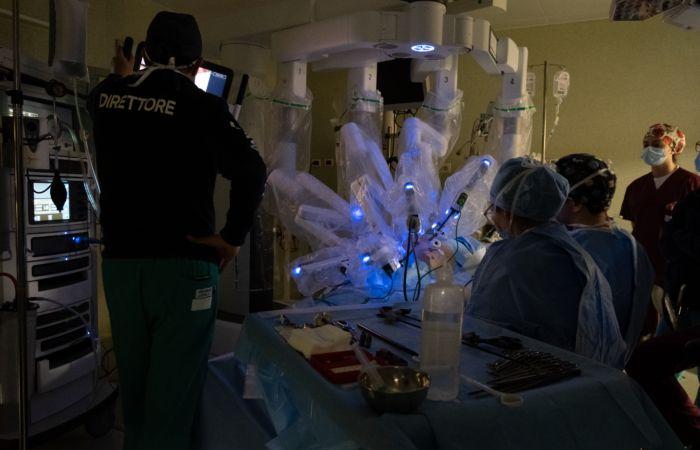The Teramo Local Health Authority has recently made an important investment in the sector of new technologies by equipping the Teramo hospital with a daVinci Xi robotic platform thanks to which it can perform minimally invasive surgical interventions using cutting-edge technology.
From the beginning of the year to the end of May, 139 robotic surgery operations were performed at Mazzini, with a constant increase. Genesis Program – May 2024
The robot allows you to optimize and implement what have always been the benefits of traditional laparoscopic surgery (less surgical stress, faster recovery times, less postoperative pain and better aesthetic result) thanks to a 3D vision, better exposure of the operating field, movements of the instruments that reproduce those of the wrist and facilitation of sutures.
“The use of the robot is part of our Local Health Authority’s propensity for continuous innovation, with the adoption of new machinery and techniques. In this case, the use of the robot allows us to minimize trauma and reduce the patient’s hospital stay. Our final goal is to increasingly increase the quality of healthcare and therefore the benefits for the patient. It is an objective that we pursue with conviction now but also for the future. Furthermore, its use is also extended to surgeries in spoke hospitals in order to give different professionals and different operating units access to this method”, comments the general director of the ASL, Maurizio Di Giosia. In fact, in May, a first session of the general surgery of Sant’Omero took place, directed by Mario Cicconi, and now we will continue with the surgeries of Atri and Giulianova.
There are four specialists that currently operate using the daVinci Xi: general surgery, thoracic surgery, urology and gynaecology.
“The General Surgery of Teramo, which already has extensive experience in minimally invasive techniques applied to oncological surgery of the digestive system, today performs all types of resection of the digestive tract with excellent results in patients eligible for this type of surgical approach. colon and rectum for both cancer and benign diseases; some stomach tumors and abdominal wall defects were also treated,” he explains Ettore Colangelodirector of the general surgery unit.
Furthermore, it is worth mentioning the case of a primary tumor affecting the Spigelian lobe of the liver (one of the “difficult” segments) which was completely removed with a robotic technique and the patient was discharged in excellent clinical conditions after just 4 days of hospitalization. This uncommon operation represents the first case performed in the region and testifies to the particular experience of the team directed by Colangelo in the management of hepatobiliopancreatic pathologies even in a minimally invasive setting.
“Robotic minimally invasive surgery is widely used in thoracic surgery. “Our Uoc”, observes the director, Duilio Divisi, “integrated the use of the daVinci Xi robot into surgical planning in April 2024, highlighting some advantages compared to Vats (video-assisted thoracoscopy) and Msam (muscle-sparing minithoracotomy). The magnified and 3D video visualization of the anatomical structures allows for a high definition of the same, an aid for the surgeon both in the dissection of the vascular components (this is a major surgery on the “large vessels”) and in the accurate determination of the resection margins above all in typical sub-lobar exeresis. Furthermore, the robotic arms allow 360° movements, inhibiting any possible natural tremor. Overall, the reduction in pleural reactivity, possible sources of bleeding and pain allows for rapid postoperative functional recovery.”
Urology is the branch in which the daVinci Xi finds the greatest application. “It allows a technologically advanced and minimally invasive approach for the treatment of all neoplastic and functional urological pathologies with countless pre-intra-post-operative benefits, both for the patient and from a clinical point of view”, point out the acting director of the Uoc of Mazzini Guevar Maselli And Federico Narcisihead of the Uosd of urology and andrology of Atri, “Robotic surgery using the daVinci robotic system – compared to traditional techniques – allows a more precise surgical gesture, less bleeding, lower risks of post-operative infection, hospitalization and recovery times are decidedly inferior.”
Noteworthy applications also in Gynecology. “It is an opportunity for surgeons and patients: in addition to the accuracy of the surgical gesture, robotic technology reduces hospitalization times. The resumption of normal activities by patients guarantees faster recovery times, and they are discharged on average within forty-eight hours following surgery in excellent conditions with minimal painful symptoms and minimal intraoperative blood loss. In the gynecological field it allows us to treat mainly patients suffering from oncological pathologies but without neglecting other pathologies, it is also very advantageous for the surgical management of obese patients”, he states Alessandro Santarellidirector of the Uoc of obstetrics and gynaecology.






